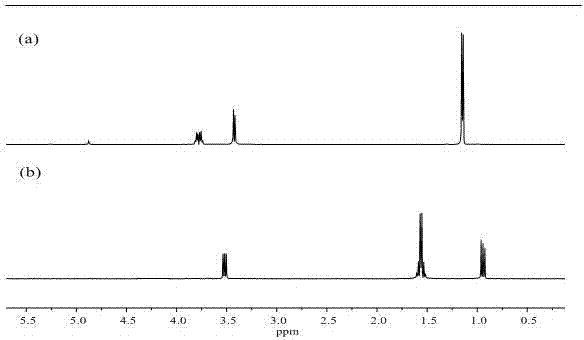Nuclear magnetic resonance detection method of glycerol hydrogenation reaction mixture
A hydrogenation reaction and nuclear magnetic resonance technology, which is applied in the analysis by nuclear magnetic resonance, material analysis by resonance, and measurement devices, etc., can solve the problems of signal overlap, redundancy, loss of nuclear magnetic information, etc., and achieve good stability and applicability , The effect of fast detection speed and high sensitivity
- Summary
- Abstract
- Description
- Claims
- Application Information
AI Technical Summary
Problems solved by technology
Method used
Image
Examples
Embodiment 1
[0034] (1) Take 1,3-propanediol (1,3-POD), 1,2-propanediol (1,2-POD), glycerol (Glycerol), n-propanol (n-PO) and isopropanol (2 -PO) each 4 mg mixed, added to 400 μL deuterated methanol solvent, after being completely dissolved, added to a 5 mm NMR tube as an analysis model for the glycerol hydrogenation reaction mixture. Put the sample tube into the main magnet of the 400MHz liquid nuclear magnetic resonance spectrometer, and the maximum gradient field strength that can be generated by the z-axis gradient coil of the nuclear magnetic resonance spectrometer is 0.5T m -1 . Put the mixture sample into the main magnet of the nuclear magnetic resonance spectrometer, set the magnet temperature to 298K, the compressed air flow to 400lph, and keep the temperature constant for 5 minutes;
[0035] (2) Call out the BPPLED pulse sequence of the diffusion sorting spectrum, set the gradient recovery delay to 2ms, the eddy current delay to 5ms, the number of scans to 8, the number of empty...
Embodiment 2
[0041] (1) Take 100 μL of the real glycerin hydrogenation reaction mixture, put it into an NMR tube, add 300 μL of deuterated methanol, and after it is completely dissolved, put the sample tube into the main magnet of a 400MHz liquid NMR spectrometer. The maximum gradient field strength that can be generated by the z-axis gradient coil of the instrument is 0.5T m -1 . Set the magnet temperature to 323K, the airflow to 500lph, and keep the temperature constant for 40 minutes;
[0042] (2) Call out the BPPLED pulse sequence of the diffusion sorting spectrum, set the gradient recovery delay to 2ms, the eddy current delay to 5ms, the number of scans to 16, the number of empty scans to 8, and the number of sampling points (TD) for each image to be 64k. Set the diffusion time (Δ) to 50ms, the gradient application time (δ / 2) to 600μs, and the gradient strength (GPZ6) to be 2% of the maximum gradient strength, collect the first one-dimensional hydrogen spectrum; set the diffusion tim...
Embodiment 3
[0048] (1) Mix 4mg of 1,2-propanediol (1,2-POD), 6mg of glycerol (n-PO) and 0.015mg of n-propanol, dissolve them in 500 deuterated dimethyl sulfoxide, and add In the NMR tube, the mass concentration of n-propanol is 34ppm (one part per million), and the sample tube is placed in the main magnet of the 400MHz liquid NMR spectrometer. The maximum gradient that can be produced by the z-axis gradient coil of the NMR spectrometer is The field strength is 0.5T·m -1. Set the magnet temperature to 300K, the air flow to 500lph, and keep the temperature constant for 60 minutes; (2) Call out the BPPLED pulse sequence of the diffusion sorting spectrum, set the gradient recovery delay to 2ms, the eddy current delay to 5ms, set the number of scans to 16, and the number of empty scans to 4 , the number of sampling points (TD) of each image is 16k. Set the diffusion time (Δ) to 50ms, the gradient application time (δ / 2) to 1500μs, and the gradient strength (GPZ6) to be 2% of the maximum gradi...
PUM
 Login to View More
Login to View More Abstract
Description
Claims
Application Information
 Login to View More
Login to View More - R&D Engineer
- R&D Manager
- IP Professional
- Industry Leading Data Capabilities
- Powerful AI technology
- Patent DNA Extraction
Browse by: Latest US Patents, China's latest patents, Technical Efficacy Thesaurus, Application Domain, Technology Topic, Popular Technical Reports.
© 2024 PatSnap. All rights reserved.Legal|Privacy policy|Modern Slavery Act Transparency Statement|Sitemap|About US| Contact US: help@patsnap.com










